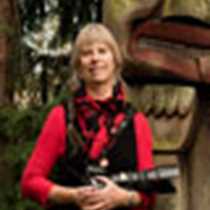The Dalles
Early this morning, National Geographic Sea Bird continued her eastern journey up the Columbia River. Our morning destination was the new port of The Dalles. Once docking was complete, our group made their way up the dock to be greeted by local residents decked out in 20th century costumes! The two local ladies greeted us all with a warm welcome and an invitation to come to town and visit any and all the local Dalles establishments...meanwhile, our two busses had arrived and slowly we boarded and began a short journey to the Columbia River Gorge Discovery Center and Wasco Historical Museum. A gorgeous building constructed partially with local volcanic rock and designed to reflect and fit into the Inland Pacific Northwest environment, located on the eastern end of the Columbia River Gorge.
Museum exhibits inside included the natural history of the area, the native peoples’ history including the building of the Dalles Dam, which covered Celilo Falls, a trading center used by native peoples for thousands of years. Finally there was a large section of the museum dedicated to the history of the Oregon Trail and the settling of Wasco County, the physical location of the Discovery Center and Historical Museum. Ample time was provided to wander the many exhibits, which was followed by time to explore the outdoors.
A natural history walk, a photo walk, and an aerobic walk were all provided by our staff. Spending time outside we all had a chance to listen, observe, and take in the aroma of this high plateau environment...the air was filled with the scent of big sage brush, which had just finished blooming. Western flickers, Steller jays, and chickadees filled the air. Clouds moved in and around the sun creating wonderful shadows and soft light for photographers. Most important, time was given to take a moment, stop and enjoy observing the transition of our travels east along the Columbia River, which cuts through the Cascade Mountain Range taking us from the temperate rain forest, past the rain shadow created by those mountains and into the high plateau. Gradually we were moving into territory that was not dominated by large stands of trees but rather a diverse collection of draught tolerant trees, shrubs, and plants that decorated the hills all around us.
All too soon, we returned by bus to the National Geographic Sea Bird where our lunch was waiting. After lunch we headed out again, this time to another unusual but very well known museum called the Maryhill Museum of Art. Situated on 26 acres, the three-story European, beaux-arts style concrete mansion, built by Sam Hill in 1917, overlooks the Columbia River and houses an extremely eclectic collection of art from around the world. From the largest collection of Rodin works in the U.S. to chess sets from around the world to a basement filled with one of the finest exhibits of native peoples regalia, baskets, tools, and household goods found anywhere in North America; each of us had a chance to lose ourselves while wandering the halls of Maryhill.
Meanwhile the sun was peeking out of the clouds outside, calling to one and all to enjoy a moment of warmth. Many of us wandered in the park-like setting that surrounds the Maryhill Museum among sculptures, patios with views over the river, and a lawn full of many varieties of wild and edible mushrooms.
In our absence the National Geographic Sea Bird was making her way through the Dalles Dam, continuing east towards the Maryhill marina park where Zodiacs were waiting to ferry our group back to the warmth of the ship. Once everyone was on board, Zodiacs were lifted and slowly the National Geographic Sea Bird positioned for an early evening entrance to the John Day Lock and dam. The sun was setting, cocktails were being poured, and a delicious display of local smoked fish was brought into the forward lounge as to accompany our evening beverages. As the National Geographic Sea Bird continued her journey east along the mighty Columbia we all had a chance to reflect on a day filled with exposure to the many peoples who have influenced, lived, and shared this land called the Inland Pacific Northwest.




